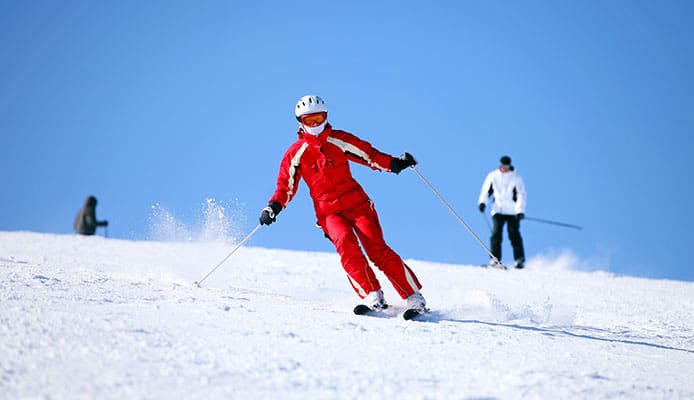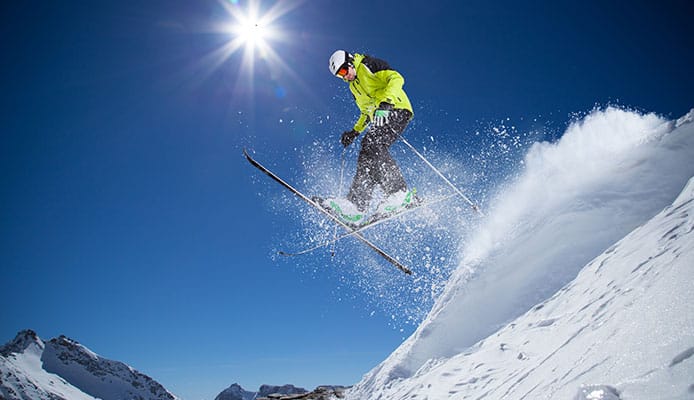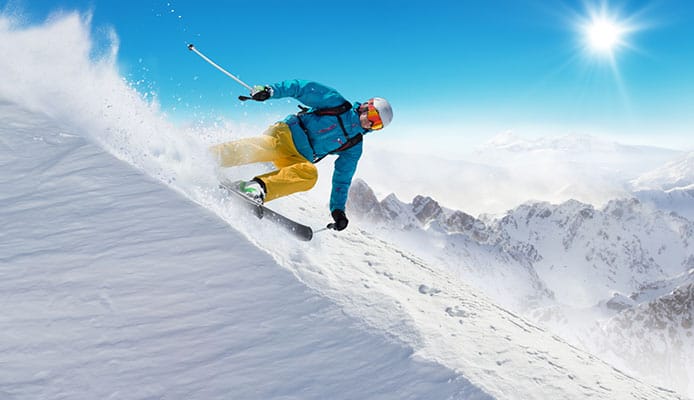
-
1.
-
2.
-
3.
-
4.
-
5.
A reliable pair of ski pants can be a real game changer once you hit the slopes – they keep you dry and warm so you can enjoy yourself without having to worry about the cold. As you’ll get the chance to see, good snow pants are equally as important to have as any other piece of ski gear.
Since these are not your everyday pants, they need to meet some criteria so they can perform well on the snow. The most important thing is protection, so you want a pair of pants that will keep your legs dry throughout the day spent skiing. Of course, it’s even better if they also block out wind and keep you warm.
With all the pants available, it’s easy to get lost in the specs and have a hard time deciding which are the best waterproof ski pants. However, as long as you know exactly what to look for, you’ll have a much easier task. This is why we created a comprehensive buying guide along with our product selection, so you can easily find a pair that won’t just keep you dry, but that you’ll also enjoy wearing.
OUR TOP PICK
Burton Men’s Covert
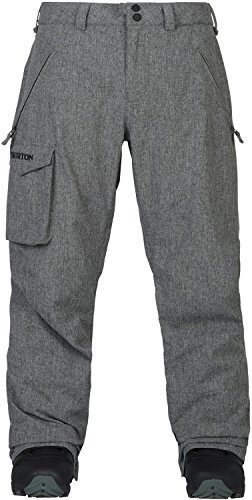
- Stand Out Features - Why We Love It
- Fantastic waterproof and breathability rating
- Fully taped seams
- Zippered vents on inner thighs
- Many great color options
- Waterproof hand pockets
- Cuff zippers for easier setup
Shell material: Polyester/Nylon (depends on the model)
Lining: Taffeta/Mesh
Waterproof rating: 10,000mm
Breathability: 10,000g
Leg gaiters: Yes
Pockets: Five
EDITORS CHOICE
Columbia Men’s Snow Gun
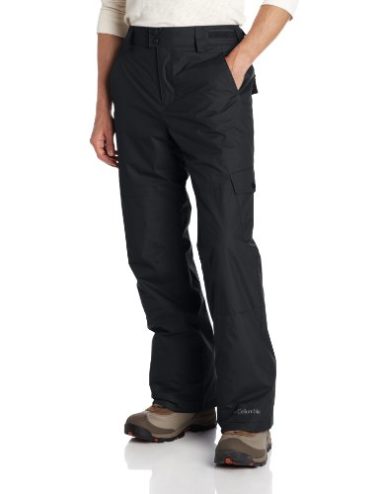
- Stand Out Features - Why We Love It
- Extra-tough nylon shell
- Machine-washable
- Adjustable waist
- Warm and breathable insulation
- Secure zippered pocket
Shell material: Nylon
Lining: Nylon
Insulation: Polyester 60g
Leg gaiters: No
Pockets: Six
BEST VALUE
Arctix Men’s Snow Sports Cargo
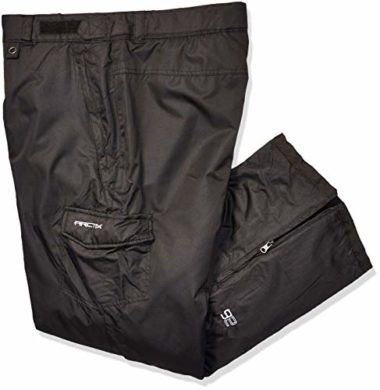
- Stand Out Features - Why We Love It
- Strategically reinforced shell
- Warm and lightweight insulation
- D-rings in cargo pockets
- Machine-washable
- Critically sealed seams
Shell material: Polyester/Nylon
Lining: Taffeta 210T
Insulation: ThermaTech 85g
Waterproof rating: 3000mm (with DWR)
Leg gaiters: Yes, with grippers
Pockets: Four
Columbia Men’s Bugaboo II
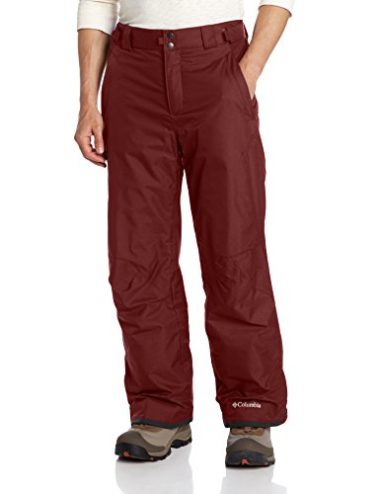
- Stand Out Features - Why We Love It
- Easily adjustable waist
- Reinforced cuffs
- Adjustable leg gaiters
- Machine-washable
- Soft and breathable lining
Shell material: Omni-tech (nylon/polyester)
Lining: Polyester Tricot
Insulation: Microtemp insulation (40g polyester)
Leg gaiters: Yes
Pockets: Two
White Sierra Toboggan
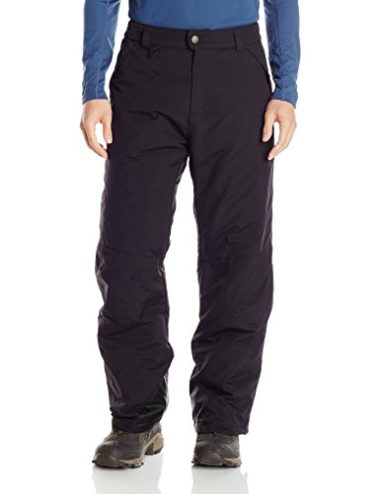
- Stand Out Features - Why We Love It
- Excellent insulation
- Leg opening is expandable
- Angled hand warmer pockets
- Reinforced scuff guard
- Machine-washable
Shell material: Nylon
Lining: Polyester
Insulation: Polyfil 120g
Leg gaiters: Yes
Pockets: Three
Arctix Men’s Mountain
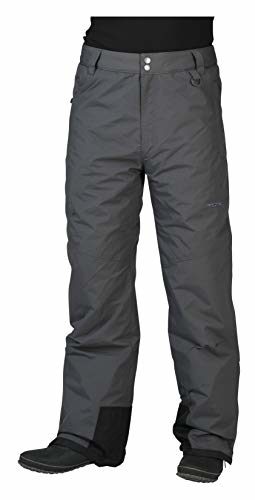
- Stand Out Features - Why We Love It
- Shell reinforced with ballistic Nylon
- Flexible and comfortable
- Boot zippers on cuffs
- Very warm insulation
- Secure leg gaiters
Shell material: Polyester/Nylon
Lining: Taffeta 210T
Insulation: ThermaTech 85g
Waterproof rating: 3000mm (with DWR)
Leg gaiters: Yes, with grippers
Pockets: Two
Columbia Ridge 2 Run II Backcountry
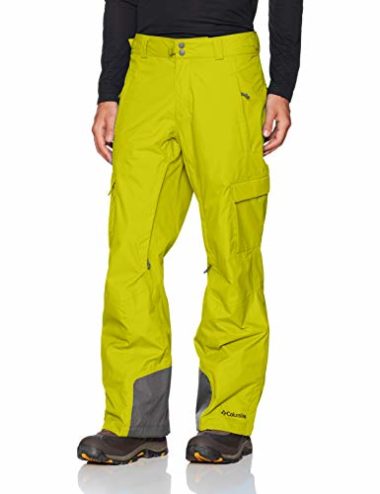
- Stand Out Features - Why We Love It
- Omni-Heat system keeps heat inside
- Fully sealed seams
- Inner leg vents
- Anti-static lining
- Lightweight and comfortable
Shell material: Nylon Legacy twill
Lining: Microtex reflective lining (polyester)
Leg gaiters: Yes
Pockets: Six
TSLA Men’s Rip-Stop Insulated
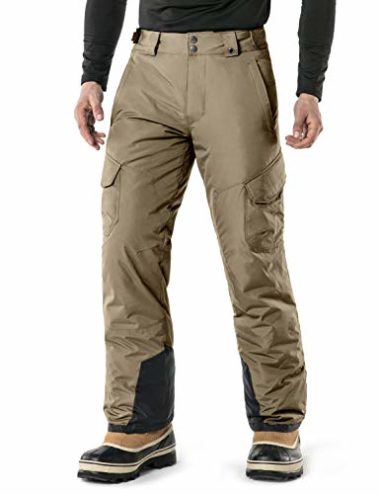
- Stand Out Features - Why We Love It
- Triple layer construction
- Velcro waistband tabs
- Secure side pockets with Velcro
- Great color options
- 30-day money-back guarantee
Shell material: Nylon
Lining: Anti-static fleece
Leg gaiters: Yes
Pockets: Four
Free Soldier Men’s Slim Fit
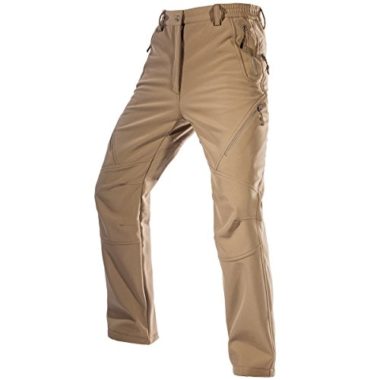
- Stand Out Features - Why We Love It
- Elastic fabric for improved movement
- Waterproof pockets with YKK zippers
- Water-repellent surface
- Elastic waist with belt loops
- Anti-static polar fleece liner
Shell material: Polyester/Spandex
Lining: Fleece
Leg gaiters: No
Pockets: Five
Singbring Outdoor Fleece Lined Windproof
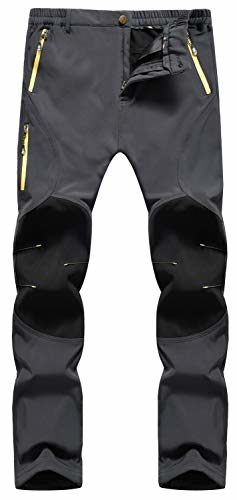
- Stand Out Features - Why We Love It
- Unisex model with men’s and women’s sizes
- Adjustable waist with belt loops
- Warm fleece liner
- Secure zippered front and back pockets
- Comfortable and breathable
Shell material: Polyester
Lining: Fleece
Leg gaiters: No
Pockets: Four
How To Choose The Best Ski Pants – Buying Guide
Finding the best ski pants isn’t that difficult, but you need to pay attention to a few details when buying. The pants you get need to be made from high-quality waterproof materials that you can rely on to keep you dry. They also need to fit well so you feel comfortable in them while going down the slope. Finally, smart features like gaiters, vents, and waterproof pockets can make using the pants more convenient and comfortable.
Waterproofing
One of the most important things when talking about ski pants is their ability to keep water out. Of course, not all ski pants are going to perform the same in this regard. This depends on the way the pants are made, and the materials used in making them. On the other hand, just saying that a pair of ski pants (or any other piece of equipment) is waterproof is not enough.
This is why we have waterproof (hydrostatic head) ratings to give us exact numbers that we can compare. This rating presents the number of millimeters of water (in a cylinder, over a square inch) that a type of fabric can resist before it starts to leak. Unfortunately, not all manufacturers test their ski pants, so you often won’t be able to know this information before buying. On the other hand, many of the best pants on the market have waterproof ratings that go well over 10,000mm and are very proud of this fact.
When selecting new ski pants, you need to keep in mind that there is a difference between water-resistant and waterproof. Being only water-resistant doesn’t cut it in ski pants, because this type of material won’t be able to protect you from a day of rolling in the snow. This is why many ski pants have an additional coating that improves the pants ability to keep you dry. This coating is usually either Teflon or DWR (Durable Water Repellent). Basically, this surface layer makes water and snow roll off the fabric, instead of sticking to it and soaking it.
You should not underestimate the importance of staying dry on the ski tracks, so carefully choose a pair of ski pants that are going to work well in the conditions you’ll be skiing in. Wet ski pants are not only uncomfortable to wear, but also drain your body heat quickly which can also lead to health risks.
Seams
The importance of sealed seams is sometimes overlooked when talking about the protective properties of ski pants and other ski gear. Seams are the joints between the pieces of fabric, and every piece of clothing has them – including your ski pants. What’s so important about them is that they are potential leaking points. It doesn’t matter if the pants are made of the most waterproof material – if the seams aren’t sealed, some small amount of water is going to find its way in.
This is why manufacturers seal the seams on ski trousers, usually by using a special type of tape. It goes on the inner side and creates a barrier that completely blocks droplets of water from coming in. As you’ve probably noticed, some ski pants have critically sealed seams, while others have seams that are fully sealed.
Critically seam-sealed means that the seams in the “critical” areas (where you’re most likely to get wet) have been sealed. For ski pants, this usually means the back area, since you’ll find yourself sitting in the snow at one point or the other. Fully seam-sealed means that all the seams on the pants are taped. This eliminates any weak points and leaves you fully protected. Unfortunately, this often also raises the price point a bit.
Breathability
Allowing your legs to breathe is necessary if you want to feel comfortable while skiing. Much like ski jackets, ski pants for skiing need to allow moisture and water vapor to get out and escape from your body. There is a high chance that you’ll get sweaty while skiing, and this is a way of staying dry.
Of course, this is not always easy to do. Except for a few very sophisticated materials (which we’ll mention later), most materials are either highly breathable or highly waterproof. Softshell ski pants generally have better breathability, so you should aim for those if this is your main concern.
You might also like: TOP Best Cross Country Ski Gloves
Similar to waterproofing, there are breathability ratings available for different materials. These are expressed in grams of vapor that are able to get through a square meter of fabric in one day, and a higher number is better. The Covert pants we featured have a breathability rating of over 10,000g which is excellent and guarantees you stay dry. Many lower-quality pants don’t have anywhere near that kind of breathability, meaning that you will get wet from your own sweat, and possibly even cold after some time.
Materials
We mentioned the significance of materials used several times so far, so it’s time to explain to them better as well as what each type of material can give you. The shell of your ski pants is usually made of either polyester or nylon, and both of them have some advantages and disadvantages.
Most of the models we featured have a polyester shell, which is an excellent choice for ski pants. While polyester is able to stop a certain amount of water on its own, its main strength is certainly the breathability and comfort it gives you. These pants feel great to wear, and you will feel nice in them the whole day. Polyester is more commonly used for softshell pants. As for waterproofing, these ski pants often come with a DWR coating (we mentioned it earlier) to help improve its ability to keep you dry.
Nylon is also a synthetic material but with some very different characteristics. It’s much tougher, especially the Ripstop and Durastop fabrics used in some of the models we talked about. It’s very resistant to wear and tear, so you can count on excellent durability. Most importantly, nylon fabrics usually have top-level waterproof ratings so they can efficiently block water. However, they are not very breathable, which can sometimes be a problem.
To get the most out of both, some manufacturers combine them in their pant models. This way you get great breathability and comfort, but you also have reinforcements in areas that see the most wear while skiing. Of course, there are some more sophisticated materials that excel in both categories (waterproofing and breathability).
These materials (Gore-Tex, eVent, and others) are specially made to have an impregnable shell that blocks out any water from coming in, but also have small pores that open to let the vapor out easily. As you can probably guess, a pair of gore-tex pants is going to cost significantly more, and we would say it’s not really necessary for a recreational skier.
As for the liner inside the ski pants, it’s usually made of synthetics. The only thing you need to worry about here is that it feels soft and that it doesn’t irritate your legs. This is why most ski pants are lined with polar fleece. In addition to feeling comfortable, fleece should also be capable of wicking away sweat and have anti-static properties.
Insulation
Ski pants can come with or without insulation, and both have certain advantages. Which one you should buy depends on your personal preference. Insulated ski pants will keep you warm but can sometimes feel too warm if the outside temperature isn’t freezing. On the other hand, uninsulated ski pants give you added flexibility and weigh less, but you must think about layering if you don’t want to freeze.
To give an example, hardshell ski pants usually come without any insulation. Their shell is very effective in blocking out wind and rain, but the pants don’t have any ability to keep the warmth inside. On the other hand, many softshell models have insulating layers that help keep the warm air inside. This insulation is usually made of synthetic materials, and its efficiency is shown in grams (how much a 1×1 meter piece of fabric weighs in grams). A higher number means that the insulation is better and that the pants are warmer.
Some pant models have a removable insulating layer, adding a whole new level of versatility. This layer is attached to the shell using zippers or snaps buttons, so you can use them together when it’s really cold outside. However, you can also use just the shell when it’s warm, or just the insulation to keep you comfy and warm when in your hotel room for example.
Pants vs Bibs
If you’re unsure what bibs are, they are a type of pants that resemble overalls – they have a high waistline and a panel that often covers your chest, with suspenders holding them in place. Whether you’ll buy bibs or regular ski pants comes down to what you like and whether you need additional protection.
The higher waistline on the bibs gives you some added protection against snow. Combined with a jacket that comes with a powder skirt, you can be sure that no amount of snow is ever going to reach your body. In addition to this, some people find bibs more comfortable since they don’t have a tight waistline to constrict you.
However, many skiers don’t think that bibs look good. This is why they avoid them and get a pair of regular ski pants. An added benefit of regular ski pants is that they are much more convenient when nature calls and you need to use the bathroom (bibs are complicated to take off). Perhaps the best option is models that come with removable bibs and suspenders, so you can transform them easily based on what you need at that moment.
Features
A good set of features can really make a difference when talking about convenience and functionality. One of the most common features on any pair of ski pants are certainly pockets. However, the design, number, and positioning of the pockets can be different. It’s best if they are closed with a waterproof zipper (perhaps even a flap over them), and that you get enough of them for all you want to bring with you.
Many models we featured come with articulated knees, which are a great addition that improves movement, and you won’t have the feeling that the pants are too stiff. In addition to this, you should make sure that your ski pants come with leg gaiters which help block out the snow and cold air from getting in. It’s also a big plus if there are cuff zippers too, to allow you to easily put the boots on. Some models also have cuff reinforcements, which is a big deal when it comes to durability.
One of the features we particularly like is the zippered vents. These are openings on the inner or outer thigh which allow you to unzip them and quickly cool yourself – a great option to have for high-energy activities like off-piste skiing. This is particularly useful on insulated ski pants which can easily get too hot.
If you buy ski pants and jackets from the same manufacturer, you may also have jacket compatibility. This allows you to connect the two (with a zipper or snap buttons) and create a barrier that prevents snow from getting in. Finally, we want to mention the Recco system. Some pant models are equipped with a Recco reflector which is a passive unit that can help the rescue services locate you if an accident happens and you’re trying to survive an avalanche.
Fit
The fit of your ski pants shouldn’t be too tight, so you can easily move your body both while on and off the skis. Ski pants come as slim, regular, and loose-fitting pants. We are not big fans of slim snow pants, because they can restrict your movement and you don’t have enough room to wear extra layers underneath if you feel cold.
Perhaps it’s the best idea to get ski pants with a regular fit. These allow you to layer underneath them and move freely but still aren’t too “baggy” to get in the way. Loose pants are more popular for snowboarding than skiing since they allow the type of movement snowboarders need. On the other hand, they aren’t as good at retaining warmth.
Whichever type you choose, make sure they are adjustable. The ski pants come with an elastic waist with Velcro straps, belt loops (good if you like wearing a belt), and cuff zippers and gaiters on the leg so the pants fit tightly on the boot. Make sure to check that the pant legs are long enough to go over your boots (or snowshoes) because pant legs that slide up can be really annoying.
Style and Color
While function is most important, no one wants to wear a piece of clothing they don’t like. This is why we tried to pick out ski pants that are not only functional but stylish too. Many of the models in our ski pants reviews are sleek looking and come in a great number of colors, so you can pick your favorite and match it with the other gear you own. There are even some very vibrant colors available that will definitely make you stand out on the slopes.
This has one more added benefit to it – you’ll be more visible on the track, so your safety is improved too. While style and color are not the primary concerns when buying your pants (for skiing at least), it’s good to give it a thought when you’ve found the right pair.
Quality and Durability
Because ski gear isn’t exactly cheap, we expect it to last at least several years. Some of the best ski pants for skiing can last for over a decade if taken care of properly. We discussed the materials a bit earlier, and you really need to pay attention to product specs when buying. Some are known to be more durable, and this can be a good indicator of what you can expect from the pants.
In addition, the brand name also plays a small role. Even though we believe that you don’t always have to buy a pair from a well-known manufacturer, it can be a good idea if you want to play it safe. Perhaps the best thing you could do is to read the experiences of other users that own the exact same model, and see whether they had any trouble with it.
In terms of durability, it’s a big plus if your ski pants have reinforcements in some areas (cuffs, ankles), so they don’t tear easily. Finally, it goes without saying that properly caring for your ski pants is going to significantly prolong their lifespan.
FAQs
Q: What Are Pants For Skiing?
These are pants specially designed for activities on the snow, in this case, skiing. What this means is that they are made from high-quality materials that can endure the conditions you face on the snow. They should be water- and windproof, so you don’t get wet and cold while on the track. In addition, they should be breathable too, so the excess moisture can escape and you don’t get sweaty and uncomfortable in them.
The fit of these pants is often a bit different since they shouldn’t limit your movement, and give you the option of layering underneath. The features you get on this type of pants are very important too – leg (powder) gaiters, zippered vents, a large number of conveniently-placed pockets, and so on. However, reliable protection is the main thing you should look for, whether you’re just learning how to ski or an experienced skier.
Q: Do I Need Any Additional Layers Under My Pants?
We can’t give you a straight answer, because this depends on two things – what type of pants you have and how warm you want (need) to be. If you have an insulated pair of snow pants, you often won’t have to wear anything underneath.
The insulation itself usually gets the job done on its own, and you would be too warm if you wore a base layer. Additionally, pants are often lined with fleece which feels soft and comfy on the skin. However, sometimes the pants have subpar insulation or the weather outside is so cold that you want to wear one more layer anyway.
On the other hand, if you have shell pants you will usually have to wear an additional layer. Shell pants will give you fantastic protection from water (snow) and wind, but won’t do much good when talking about warmth. This is why you need to invest in a good base layer to compensate for the missing insulation and retain some of your body heat.
When choosing a layer that you’ll wear under your pants, avoid materials like cotton, which is terrible when wet. Instead, you should go for something made of synthetics or, even better, wool. These feel great on the skin, and don’t irritate it. They efficiently keep the warmth close to your body but are also able to wick away sweat so you stay dry underneath. In addition, they also have a mild compressive effect, which helps with circulation and performance.
If you plan to layer under your pants, make sure you get a regular or loose fit so you have enough room for the additional clothing. Even though layering under the pants is not as important as layering under a jacket (keeps your body core warm), doing it can be useful in many situations.
Q: What Are Powder Gaiters And Why Do I Need Them?
Powder (leg) gaiters are extensions to your pants inside the pant legs. This is an elastic gaiter that stretches around your boots and serves as a barrier that prevents snow and wind from getting inside your pants. If you’ve ever tried regular pants for skiing and snow activities, you know how irritating it can be when they slide up and the snow gets inside the cuff or into the boots. You get very cold, wet, and feel unpleasant. Powder gaiters help avoid that.
They also keep the pants in place not just when skiing, but also when walking in deep snow. Finally, they help keep the warmth inside the pant legs, preventing it from escaping. It’s a fantastic addition that you can find on all the best snow pants models. Consider getting a pair that has powder gaiters – you won’t believe the difference in comfort they give you.
Q: Does Color Matter With My Pants?
No, color is not that important. When discussing functionality, it doesn’t really matter which color your pants are – as long as they are made of high-quality materials that can guarantee you stay protected once you hit the snow. This being said, we all like to have matching ski equipment. It’s excellent if a manufacturer gives us enough color choices so we can match the pants to the color of our skis or helmets, so we can look better while riding.
Another reason to choose a certain color may be practicality. If you have darker-colored pants (black, brown, green), an added benefit is that it won’t show right away when they get dirty, so it won’t annoy you. On the other hand, brightly-colored pants (pink, yellow, neon green) significantly increase visibility. Other skiers will see you better, and the rescue services will spot you sooner if you’re in trouble.
Q: What Is The Difference Between Ski And Snowboarding Pants?
The biggest difference is certainly the fit – pants for skiing are usually slimmer than those made for snowboarding. These pants give you added warmth because they don’t need to be very loose. This is not to say that these pants are slim, but that snowboard pants are often very baggy so they perform better while on the board.
Furthermore, you’ll often hear people saying that this type of pants lasts longer. While this may be true, we think it has much more to do with the way both of these types are used (snowboard pants see more wear and tear), than with the materials used or the quality itself. Of course, both types can be used interchangeably for both activities – the main thing is that you feel protected and comfortable.
Globo Surf Overview
As you had the chance to see, a good pair of ski pants has a very important place on your equipment list. Your whole body needs to stay dry and warm during a day out on the snow, including your legs. Choosing the best ski pants for your skiing style will not only give you this but also make you feel very comfortable on the track.
The most important thing is finding a well-made pair that fits you properly and has all the features you need. Luckily, you now have all the information you need, so this shouldn’t be a hard task anymore. There are many tried and tested models on our list, and we’re sure you can find something you’ll be happy with.
More Snow Ski Gear Reviews:
- Skiing Books
- Backcountry Ski Bindings
- Women Ski Boots
- Cross Country Ski Boots
- Women’s Skis
- Watches For Skiing
- Ski And Snowboard Tuning Vises
- Ski And Snowboard Wall Racks
- Kids Ski Helmets
- Ski Gloves For Kids
- Photochromic Ski Goggles
- Ski Boots For Kids
- Kids Ski Poles
- Ski Boots For Narrow Feet
- Ski Locks
- Ski Goggles For Flat Light
- Kids Ski Goggles
- Ski Walkie Talkies
- Ski Helmet Headphones
- Ski Carry Straps
- Ski Helmets With Visors
- Ski Boots For Wide Feet
- OTG Ski Goggles


